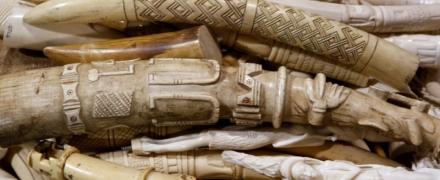open 10 am - 7 pm
laboratory is closed
Bone, not leg

Decorative items and personal adornments made of mammalian bones are known from archaeological finds associated with the first people. Initially, these were drilled fragments of animal bones and teeth. The earliest of them were untreated, and then carved notches and patterns appeared. Later, people began to make decorative and cult carved figures, however, the use of jewelry as parts was only in the historical periods associated with the artistic processing of metal. In view of its instability to environmental factors (the oxidizing effect of oxygen, changes in humidity and temperatures), bone was rarely used in the manufacture of small expensive jewelry, and more often when decorating massive objects such as thrones, book frames, as well as in the design of utilitarian products - table setting items, weapons, etc. The Victorian era in jewelry fashion left its mark not only in the form of products with a predominance of jet and pearl inserts, but also in the use of carved bone products as jewelry inserts. These could be openwork cut-out compositions, cameos and intaglios, as well as flat polished inserts, both profiled and in the form of plates and cabochons. What kind of bone was used to make them? Most often in simple inexpensive products was the bone of cattle - the tarsus (metacarpal and metatarsal bones of the limbs). The expensive items used elephant tusk, hippopotamus tooth, “fish tooth” (walrus tusks), sperm whale teeth, killer whales and narwhal teeth. Nowadays, since hunting for elephants and whales is prohibited in almost all countries, these types of bones come across very rarely and mainly in antiques. Modern bone cutters use the bone of a mammoth tusk and, in much smaller quantities, a walrus tusk for their work, and no one has canceled the most massive raw materials in the form of cattle bones, but this material, due to its small thickness, is only suitable for making plates and linings. Products made from mammoth ivory can reach dimensions of more than 10 cm in all three dimensions. All carved bone products, as a rule, are treated with protective compounds that prevent the destruction of this material when in an aggressive environment.
В геммологической практике бывают весьма увлекательные случаи с диагностикой ювелирных вставок
Но помимо редкости цвета и высокой стоимости таких камней, многие розовые камни выделяются одной замечательной особенностью – они проявляют плеохроизм, то есть в зависимости от положения осмотра камня он может иметь дополнительные оттенки – оранжевый или пурпурный.
Currently, gemstones are produced by two fundamentally different technological methods - the High Pressure - High Temperature method (“HPHT”, High-pressure & High-temperature) and the Chemical Vapor Deposition (“CVD”, Chemical vapor deposition) method. The "HPHT" method is the most tested classical synthesis method, which can be used both carbon deposition on diamond from flux melts and catalytic reactions. In "CVD" synthesis, diamond growth occurs on a seed during carbon deposition mainly from a gaseous medium at relatively low temperatures and pressures.
Jewelry and precious stones are just such a category of goods, when buying which you need to pay attention to many criteria.
Sogdianite is a rather rare mineral and more often it can be found as a collection material (moreover, in systematic collections), and it is extremely rare in jewelry.






